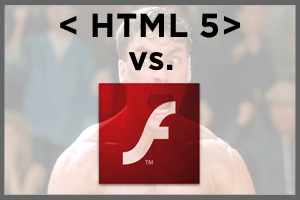Flash is dead. Long live Flash.
04.05.10 · Greteman Group
Image courtesy of FlashInYourFace.com
There’s a war going on that you may have heard about. The two sides have been saber rattling for some time now, and it’s only getting uglier. But this isn’t a war fought between nations; it’s between two tech companies – Apple and Adobe. The contentious issue is Flash, Adobe’s multimedia product that allows video, animation and interactivity in your browser window. Flash is everywhere on the Internet. You’ve seen it even if you haven’t realized what it is. Hulu shows videos inside a Flash player, and the Facebook game you’re addicted to (FarmVille anyone?) was probably created in Flash as well. For years, Flash has been what’s made the web, well, more interesting.
The problem is Apple’s new product, the iPad, which Apple fans are comparing to the wheel in historical importance. It won’t play Flash. At all. Go to a website that uses Flash and you’ll just see an ugly icon that indicates all the glorious Flash content is not for you, iPad user. iPhone owners are already used to this, since it doesn’t support Flash either. But the iPad is being marketed as a replacement for your desktop computer’s web browser, while the iPhone is better at viewing mobile-friendly versions of websites, which typically haven’t had Flash content anyway.
The Finger Pointing Begins – Arguments on Both Sides
So why does Apple have a problem with Flash? According to Steve Jobs, Flash uses up too much of your computer’s processing power, is full of security holes, and is buggy, leading to browser crashes. All of these things are, to varying degrees, true. Apple says the future lies in a new technology being developed, HTML5. They say that everything Flash does now, HTML5 will do instead.
Pro Adobe forces counter with the argument that Flash works much better on Windows computers than on Macintosh computers, because Apple doesn’t allow Flash to access the Macintosh hardware that would speed it up. They also say that, currently, support among browsers for HTML5 is spotty and that standards haven’t been completely worked out. Developing for Flash takes less time because content looks the same across browsers, so there’s less testing. And since the Flash plugin is installed in around 98 percent of computers, it currently has a greater reach than HTML5. Most importantly, Flash does things that HTML5 currently can’t do.
We Love Things that Begin with a Lowercase “I”
We have to admit it, gadgets like the iPad make us drool down our black turtlenecks. It promises a more convenient way to browse the Internet, untethered from the desktop and with a larger screen than your smartphone. With this new device comes new opportunities for our clients to get their message out. The question Greteman Group has to answer is whether or not to use Flash in our clients’ websites, since the iPad doesn’t support it.
So which side should we back, Adobe or Apple? At this point in time, it doesn’t make sense to exclusively jump into bed with either of them. Flash isn’t going away in the near future, it’s too ingrained in the Internet, and the benefits over HTML5 make it too attractive to abandon. While projections indicate that the iPad might sell between 2-10 million units in the first year, that’s a pittance compared with the number of desktop computers out there – computers that can view Flash. And there’s nothing that says that Apple won’t eventually give in and allow Flash on their devices. It would only take updating their software. So while we’re not yet giving up on Flash, we’re also keeping abreast of HTML5 and its capabilities.
Our Solution to the War – Live and Let Live
Right now, our recommendation is to keep developing Flash content if your site warrants it, and serve up non-Flash content to people who might be viewing your site on an iPad. The code that does this is already built into the Flash standards. iPad content could be in HTML5 if it’s necessary to try and mimic the Flash content, or it could simply be static images. Anything other than the dreaded “You can’t see this content” icon. If in the future Flash looses favor to HTML5, we’ll change how we build websites. But for now, utilizing the best of both worlds seems to make the most sense.
Greteman Group’s goal is to serve our clients and their audiences as best we can, regardless of technology. We immerse ourselves in digital culture so we can provide the smartest solutions in an increasingly complex online landscape. And if in the future a device comes out that beams websites directly into your brain, you can be sure that we’ll find the best way to use it. But only for good.
